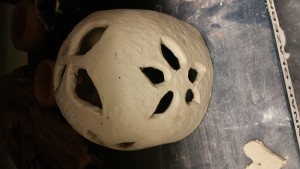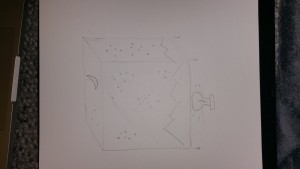Ceramic Skybox: Design Proposal
November 3rd, 2015 By hannahjgbDesign Proposal Hannah Glazebrook
Foundation
Importance of Craft
In Shiner’s “Fate of Craft”, he states that for work to be considered craft, it must be – made by hand, have a use or purpose, be created by a craft master, and have an emphasis on material. Since we can’t do all 4 in this class (mastery takes 10,000 hours or more), I want to focus on material and use, with my final project being made by hand. I want to focus on what clay can do, the way that it could cast light differently with glaze, thickness of walls, etc. I also want to create something that will be used by someone and have a purpose other than just decoration.
Material and Use
Looking at Silve’s “Romanticism” paper gave me ideas on how different materials affect how light can be displayed. My 11-month old son is in love with lights, and I would love to be able to create something that he can look at and explore. Additionally, Giaccardi spoke about the sentimentality of objects, and that fascinated me with respect to how artifacts can take on a life of their own.
Bringing in the Digital
One of the most interesting phenomena in the digital realm (to me, anyway) is the way in which playing video games can have an impact on emotions, and how sentimental reminders from games such as toys and artifacts inspired by the game can evoke those emotions. There is also research relating to how video game immersion can be impacted by digital design decisions. That inspired me to create a physical artifact that could reflect these digital experiences and bring them into the real world.
Concept
My initial thought was to try and create a light fixture that evokes the feeling of a game. My inspiration was lamps that can cast stars on the wall like this.

(image source: https://s-media-cache-ak0.pinimg.com/736x/dc/61/62/dc61626efb13d9055534f0c89755c169.jpg)
After considering the ways in which this lamp might take form, I considered various techniques including coil-building, slip-casting, and building the object as a cube or box.
The box idea got me thinking about whether I could replicate a skybox from a digital game into a real-world skybox that either could be looked inside, or could project outwards.
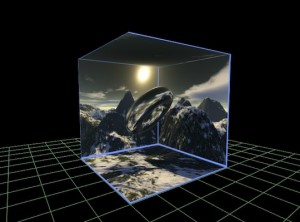
image source: https://s-media-cache-ak0.pinimg.com/736x/dc/61/62/dc61626efb13d9055534f0c89755c169.jpg
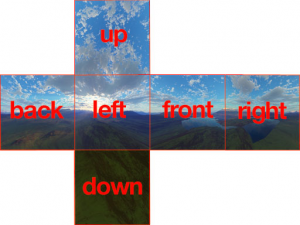
image source: https://s-media-cache-ak0.pinimg.com/736x/dc/61/62/dc61626efb13d9055534f0c89755c169.jpg
Intervention in Form
I considered building the form in multiple shapes.
Dome-Shaped
Can be hand-built or slip cast, must deal with translating images to a dome-shape and maintaining shape.
It could also be built as the shape of a cube, and built by rolling the clay, and then piecing it together.
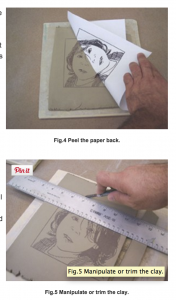
Clay tiles can be carved and then affixed together to form a cube – (image source: ceramicartsdaily.org/education/ink-transfers-on-clay/)
By varying the thickness of the walls or carving them out, the form could change the appearance of the the lamp both in translucency/opacity and in shape.
Interventions in Color
There is also a possibility to try and impact the light quality through color. One way is through Arduino. By using multicolor LEDs, I could change the appearance of the environment to be more blue, bright, red, etc.
Another possibility is changing the colors of the glazes, and mapping the colors from images in the game to the colors glazed on the lamp.
Another possibility could be using multi-colored slip casting. This would likely be more challenging and require more skill and training, but would allow the color to be actually inside the clay rather than on top.
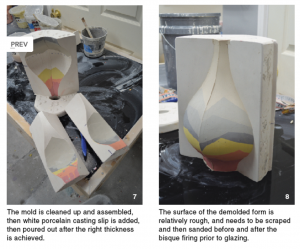
Image link: ceramicartsdaily.org/pottery-making-techniques/making-ceramic-molds/applying-colored-slips-to-a-plaster-mold-before-slipcasting-for-surface-pattern/
How is it transformative?
The project brings the digital into the physical.
The project brings sentimentality to a digitally-inspired and modified physical object.
The experience from the game shapes the object, the object might shape the way you relate to the game.
There is a dialogue between digital experiences and physical experiences
The digital doesn’t just fit inside the physical, it shapes the form, color, and experience of the physical artifact.
References:
- Giaccardi, E., & Karana, E. (2015). Foundations of Materials Experience: An Approach for HCI. Paper presented at the Proceedings of the 33rd Annual ACM Conference on Human Factors in Computing Systems, Seoul, Republic of Korea.
- Shiner, L. (2010). The Fate of Craft. In S. Alfoldy (Ed.), NeoCraft: Modernity and the Crafts (pp. 33-47). Halifax: The Press of the Nova Scotia College of Art and Design
- Silve. The Romanticism of Digital Making, for Craft Research and Practice, and the Upshot for Teaching Future Voices.
- http://alisonmcmahan.com/sites/default/files/articles/ch3-McMahanrev.pdf
